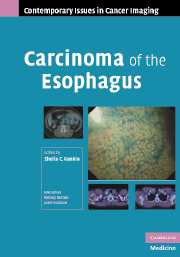Book contents
- Frontmatter
- Contents
- Contributors
- Series foreword
- Preface to Carcinoma of the Esophagus
- 1 Epidemiology and Clinical Presentation in Esophageal Cancer
- 2 Pathology of Esophageal Cancer
- 3 Recent Advances in the Endoscopic Diagnosis of Esophageal Cancer
- 4 Endoscopic Ultrasound in Esophageal Cancer
- 5 CT in Esophageal Cancer
- 6 FDG-PET and PET/CT in Esophageal Cancer
- 7 The Role of Surgery in the Management of Esophageal Cancer and Palliation of Inoperable Disease
- 8 Chemotherapy and Radiotherapy in Esophageal Cancer
- 9 Role of Stents in the Management of Esophageal Cancer
- 10 Lasers in Esophageal Cancer
- Index
- References
2 - Pathology of Esophageal Cancer
Published online by Cambridge University Press: 08 August 2009
- Frontmatter
- Contents
- Contributors
- Series foreword
- Preface to Carcinoma of the Esophagus
- 1 Epidemiology and Clinical Presentation in Esophageal Cancer
- 2 Pathology of Esophageal Cancer
- 3 Recent Advances in the Endoscopic Diagnosis of Esophageal Cancer
- 4 Endoscopic Ultrasound in Esophageal Cancer
- 5 CT in Esophageal Cancer
- 6 FDG-PET and PET/CT in Esophageal Cancer
- 7 The Role of Surgery in the Management of Esophageal Cancer and Palliation of Inoperable Disease
- 8 Chemotherapy and Radiotherapy in Esophageal Cancer
- 9 Role of Stents in the Management of Esophageal Cancer
- 10 Lasers in Esophageal Cancer
- Index
- References
Summary
Introduction
Worldwide, squamous cell carcinoma is the most common malignant epithelial tumor of the esophagus. The majority of remaining tumors are adenocarcinomas, the incidence of which has been increasing dramatically in the last few decades in the Western world. Rarely, adenosquamous carcinoma and small cell carcinoma may occur.
This chapter will focus on the morphologic features of esophageal carcinoma and associated precursor lesions.
Histopathology of tumor types
Squamous cell carcinoma
Precursor lesions – hyperplasia and dysplasia
Squamous cell carcinoma is thought to develop through a multistep process from basal hyperplasia due to chronic esophagitis through increasing severity of dysplasia to invasion.
Dysplasia is defined as the presence of unequivocal neoplastic cells confined to the epithelium. It is seen more commonly in high cancer risk areas, e.g., China, is frequently seen adjacent to invasive carcinomas, and is often multifocal.
Traditionally, dysplasia has been classified as mild, moderate, or severe (and carcinoma in situ). More recently, a two-grade system for dysplasia in the gastrointestinal tract is preferred, with mild and moderate atypia being classed as low grade and severe dysplasia and carcinoma in situ as high grade.
The risk of carcinoma rises with increasing severity of dysplasia. A recent study from China has shown a relative risk of 2.9 for mild dysplasia, 9.8 for moderate, 28.3 for severe, and 34.4 for carcinoma in situ at 13 years follow-up.
- Type
- Chapter
- Information
- Carcinoma of the Esophagus , pp. 14 - 27Publisher: Cambridge University PressPrint publication year: 2007
References
- 1
- Cited by



